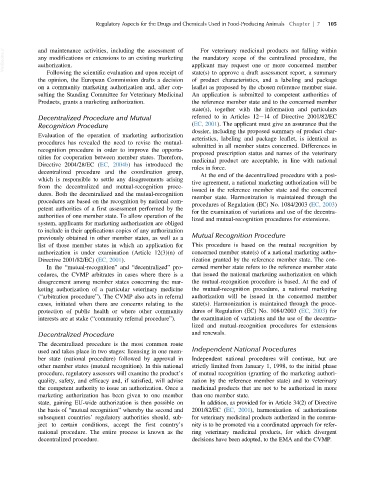Page 138 - Veterinary Toxicology, Basic and Clinical Principles, 3rd Edition
P. 138
Regulatory Aspects for the Drugs and Chemicals Used in Food-Producing Animals Chapter | 7 105
VetBooks.ir and maintenance activities, including the assessment of the mandatory scope of the centralized procedure, the
For veterinary medicinal products not falling within
any modifications or extensions to an existing marketing
applicant may request one or more concerned member
authorization.
Following the scientific evaluation and upon receipt of state(s) to approve a draft assessment report, a summary
the opinion, the European Commission drafts a decision of product characteristics, and a labeling and package
on a community marketing authorization and, after con- leaflet as proposed by the chosen reference member state.
sulting the Standing Committee for Veterinary Medicinal An application is submitted to competent authorities of
Products, grants a marketing authorization. the reference member state and to the concerned member
state(s), together with the information and particulars
Decentralized Procedure and Mutual referred to in Articles 12 14 of Directive 2001/82/EC
Recognition Procedure (EC, 2001). The applicant must give an assurance that the
dossier, including the proposed summary of product char-
Evaluation of the operation of marketing authorization
acteristics, labeling and package leaflet, is identical as
procedures has revealed the need to revise the mutual-
submitted in all member states concerned. Differences in
recognition procedure in order to improve the opportu-
proposed prescription status and names of the veterinary
nities for cooperation between member states. Therefore,
medicinal product are acceptable, in line with national
Directive 2004/28/EC (EC, 2004b) has introduced the
rules in force.
decentralized procedure and the coordination group,
At the end of the decentralized procedure with a posi-
which is responsible to settle any disagreements arising
tive agreement, a national marketing authorization will be
from the decentralized and mutual-recognition proce-
issued in the reference member state and the concerned
dures. Both the decentralized and the mutual-recognition
member state. Harmonization is maintained through the
procedures are based on the recognition by national com-
procedures of Regulation (EC) No. 1084/2003 (EC, 2003)
petent authorities of a first assessment performed by the
for the examination of variations and use of the decentra-
authorities of one member state. To allow operation of the
lized and mutual-recognition procedures for extensions.
system, applicants for marketing authorization are obliged
to include in their applications copies of any authorization
previously obtained in other member states, as well as a Mutual Recognition Procedure
list of those member states in which an application for This procedure is based on the mutual recognition by
authorization is under examination (Article 12(3)(n) of concerned member state(s) of a national marketing autho-
Directive 2001/82/EC) (EC, 2001). rization granted by the reference member state. The con-
In the “mutual-recognition” and “decentralized” pro- cerned member state refers to the reference member state
cedures, the CVMP arbitrates in cases where there is a that issued the national marketing authorization on which
disagreement among member states concerning the mar- the mutual-recognition procedure is based. At the end of
keting authorization of a particular veterinary medicine the mutual-recognition procedure, a national marketing
(“arbitration procedure”). The CVMP also acts in referral authorization will be issued in the concerned member
cases, initiated when there are concerns relating to the state(s). Harmonization is maintained through the proce-
protection of public health or where other community dures of Regulation (EC) No. 1084/2003 (EC, 2003) for
interests are at stake (“community referral procedure”). the examination of variations and the use of the decentra-
lized and mutual-recognition procedures for extensions
Decentralized Procedure and renewals.
The decentralized procedure is the most common route
used and takes place in two stages: licensing in one mem- Independent National Procedures
ber state (national procedure) followed by approval in Independent national procedures will continue, but are
other member states (mutual recognition). In this national strictly limited from January 1, 1998, to the initial phase
procedure, regulatory assessors will examine the product’s of mutual recognition (granting of the marketing authori-
quality, safety, and efficacy and, if satisfied, will advise zation by the reference member state) and to veterinary
the competent authority to issue an authorization. Once a medicinal products that are not to be authorized in more
marketing authorization has been given to one member than one member state.
state, gaining EU-wide authorization is then possible on In addition, as provided for in Article 34(2) of Directive
the basis of “mutual recognition” whereby the second and 2001/82/EC (EC, 2001), harmonization of authorizations
subsequent countries’ regulatory authorities should, sub- for veterinary medicinal products authorized in the commu-
ject to certain conditions, accept the first country’s nity is to be promoted via a coordinated approach for refer-
national procedure. The entire process is known as the ring veterinary medicinal products, for which divergent
decentralized procedure. decisions have been adopted, to the EMA and the CVMP.

